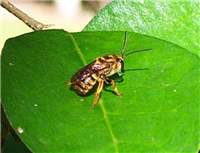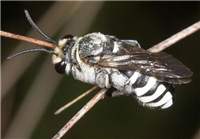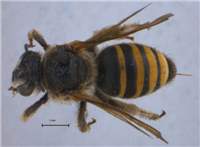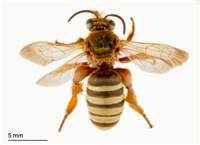Scientific Classification
Species in the Genus
Species in Kenya, Tanzania & Uganda
Description
Possible Causes of Confusion
Distribution in Kenya, Tanzania & Uganda
Habitats
Nesting
Crops Visited
Other Plants Visited
Economic / Ecological Importance
Threats
Conservation and Management Practices
Legislation (National and International)
References
Editors
Acknowledgements
Contact
Click on images to enlarge

Nomia species. Photo by moreMangostteens (CC BY-NC)

Nomia species. ©Bernhard Jacobi

Nomia species (female) - pinned specimen. Photo: Connal Eardley

Nomia species (male) - pinned specimen. Photo: Connal Eardley
Summary
Honey bees are not the only bee species that are significant for human wellbeing. Nomia bees are a group of native bee species that do not produce honey but they are important pollinators of crops and wild plants. Nomia bees are not aggressive, although they do have a mild sting that is much less painful than that of a honey bee. They can sting for defence. They are solid looking small-medium sized (7-12 mm in length) bees with light sometimes glossy stripes on the abdomen . Nomia bees nest in the ground and live independently (i.e. they are solitary). This fact sheet provides information about these bees to encourage farmers to understand and protect them to help ensure that their crops are effectively pollinated.
From a conservation and agricultural standpoint it is not necessary to recognise all the different bee genera. However, it is important to know that there is a large bee biodiversity. Different bee genera pollinate different plant species, although there is some overlap that acts as a buffer as bee populations wax and wane. For healthy ecosystems, including agro-ecosystems both diversity and abundance in the bee fauna is important.
Common Name (Language)
Alkali bees, sweat bees (English)
Scientific Classification
Kingdom: Animalia
Phylum: Arthropoda
Class: Insecta
Order: Hymenoptera
Family: Halictidae
Subfamily: Nomiinae
Genus: Nomia Latreille, 1804
Species in the Genus
Nomia bee species are a genus of sweat bees in the family Halictidae with over 130 named species which are found in most parts of the world.
Species in Kenya, Tanzania & Uganda
Around 20 Nomia species have been recorded in
Description
Nomia bees are not well known by local people (including farmers) in
Possible Causes of Confusion
Some insect species look like large Nomia bees: These are other bees in the family Halictidae (Lipotriches and Pseudapis), Meganomia and some Ceratininae bees, which are heavily sclerotised (“armoured�?) and often have enlarged back legs. The pale bands on the abdomen of Nomia bees are distinctive within the tribe but there can be confusion with Patellapis (Zonhalictus) that also has pale bands on the abdomen .
Distribution in Kenya, Tanzania & Uganda
Nomia bees are found in most districts/regions of
Habitats
Nomia bees can be found in various habitats (land-uses) in East Africa such as grasslands, natural forests, wetlands, marshlands, open habitats, protected areas, farmlands, rangelands, woodlands, woodlots (forest plantations), riparian areas.
Nesting
Although characterized by a variety of nesting behaviours, these bees are solitary, ground-nesting bees (Michener 2007). Nomia bees are commonly found nesting in termite mounds in shaded and dry places in different semi-natural habitats.
Crops Visited
Nomia bees in
Other Plants Visited
In
Economic / Ecological Importance
Little information exists on the usefulness of these bees to the lives of the people in
Threats
In
Conservation and Management Practices
Little information exists on the usefulness of these bees to the lives of the people in
Legislation (National and International)
There is not yet any legislation in
References
1. Eardley CD, Gikungu MW and Schwarz MP (2009) Bee conservation in Sub-Saharan Africa and
2. Eardley CD, Kuhlmann M and Pauly A. (2010) The Bee Genera and Subgenera of sub-Saharan
3. Eardley CD and Urban R (2010) Catalogue of Afrotropical bees (Hymenoptera: Apoidea: Apiformes). Zootaxa, 2455: 1–548.
4. Michener CD (2007) The Bees of the world, the John Hopkins University Press,
Editors
Théodore Munyuli, Busitema University - Uganda; Muo Kasina, Kenya Agricultural Research Institute (KARI) - Kenya; Juma Lossini, Tropical Pesticides Research Institute (TPRI) – Tanzania; John Mauremootoo, BioNET-INTERNATIONAL Secretariat – UK; Connal Eardley, Plant Protection Research Institute (PPRI) – South Africa.
Acknowledgements
We recognise the support from the Kenya Agricultural Research Institute (KARI), Tropical Pesticide Research Institute (TPRI) –
Contact
BioNET-EAFRINET regional coordinator: [email protected]












